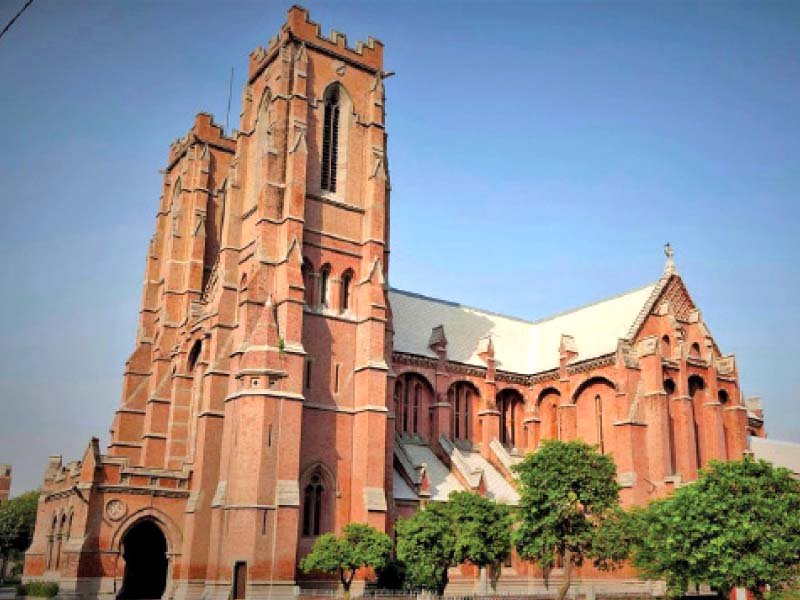
Article by
Out of about 70s mosques, temples, places of worship, shrines and other buildings of religious nature in the City, which are more than a century old, we find not a single church or place of Christian worship. The only exception being that of one church east of Shahi Mohalla near the Badshahi Masjid. The church is of comparatively recent origin and construction. The oldest church building of Lahore lies a couple of kilometers outside the walled City and is hidden from public views, by the shops of Anarkali bazar on one side and the Oriental College on the other.
According to Syrian accounts, Pakistan’s links with Christianity seem to go back around 2,000 years as according to these chronicles St-Thomas, one of the Disciples of the Christ, passed through this part of the world on his way to the south of the South Asian Subcontinent. Saint Thomas moved on to Madras, where he met an unfortunate brutal end at the hands of the Hindus. He was murdered by the Brahmins and now rests in peace there.
Christianity seems to have made no significant impact here for the next 15 centuries or on after this event, though some say that a group of Faqeers, somewhere near Thatta claim to be descendants of the disciples of St-Thomas. Besides, according to the same source, there were Christian communities settled in the north west of India now Pakistan, between the fifth and eighth century as the Church in Iran was quite active in those days.
In 1935 a Cross was discovered in Sirkap, Taxila and is housed in the Lahore Cathedral. According to a book published over half a century ago, Christ visited this part of the world incognito. Local legends say that Murree is the burial place of Mariyam, the Blessed Virgin. All such evidence, hypotheses and views fail to explain the absence of Christianity from this area.
It was only in the days of Mughal Emperor Akbar when we find evidence of contacts between the Court and the Church. We hear from a present-day chronicler that a certain Father Pereira arrived, in 1579, at the court of Akbar, from Calcutta. This view needs correction, as this scribe feels that since Calcutta was founded as an important place worthy of having a Church, only after 1690, when the East Indian Company arrived and established a factory there. Father Pereira must have arrived from elsewhere, perhaps Goa, or some Portuguese territory, as did Fathers Monserrat and Acquaviva.
One hears of a succession of missions of Jesuits Fathers arriving at Akbar’s court and of Akbar ordering to build in 1595, in Lahore, a Church for Father Jerome Xavier a nephew of Saint Francis Xavier. Some accounts say that the church was within the precincts of the Lahore Fort.
Some local historians have noticed that Akbar, who had a Plaque installed at the time of renovation. The Spanish Christian wife too, took more than usual interest in the work of the missionaries, who were allowed a fair degree of freedom. He was also fond of listening to litanies, which must have been rendered in Persian. A certain Father Pinherio was said to be fluent in Persian.
The spirit of tolerance of the days of Akbar, continued during the times of his successor. Jahangir, but matters took a different turn during the age of Shahjahan at whose doorsteps the local christian historian lay the activity and closing down churches. They also claim that owing to such changed attitude of the ruler, no evidence if Christian activity has been found in that or later Mughal and Sikh periods, However, they fail to elaborate that Shahjahan’s inimical attitude was the result of the friction that the Portuguese had voluntarily or involuntarily created.
Again during the Sikh period, we find that there were many Christian officers in Ranjit Singh’s army and some of them enjoyed great prestige. It is not comprehensible that they were not allowed religious freedom. Some of the officers raised families had children and died here. It is difficult to believe that there would have been no arrangement for religious services and a proper premise for that. Ranjit Singh was noted to have always received Christian missionaries with courtesy and listened to them with interest.
It was more than two centuries after Shahjahan’s time that the church returned to this place. When the Punjab was occupied by the forces of East India Company, chaplains of many denominations found their way to Lahore, accompanying the regiments of the troops with whom they were serving.
 Monthly "Azeem English Magazine", launched in 2000, records the information about diverse fields like mental health, literature, research, science, and art. The magazine's objective is to impart social, cultural, and literary values to society.
Monthly "Azeem English Magazine", launched in 2000, records the information about diverse fields like mental health, literature, research, science, and art. The magazine's objective is to impart social, cultural, and literary values to society.
+92 51 88 93 092
First Floor, RAS Arcade, Eidhi Market, Street#124, G-13/4, Islamabad, Pakistan, 44000.